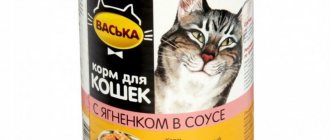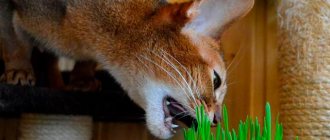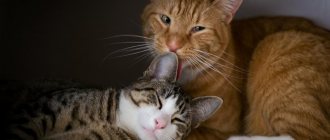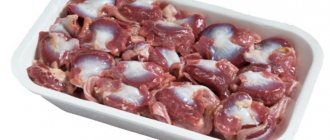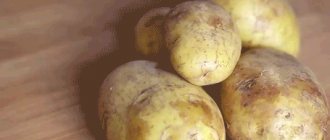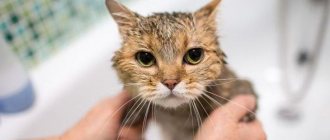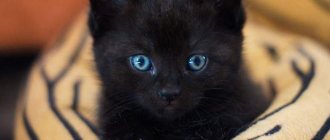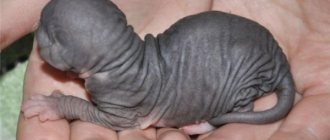I myself have never cooked porridge with fish for my cat.
But once a month, maybe less often, my mother definitely cooks Muska porridge with fish, for this she takes oatmeal and blue whiting fish. First, the fish is cooked for about twenty minutes, then oatmeal is added to it.
The one your cat eats. In general, pollock, herring, whiting are the most profitable in the price range. And there is no such fish oily smell.
My cat eats dry food, but from time to time I cook her oatmeal porridge with fish. I usually take whiting, cut it into pieces and cook for about 20 minutes. Then add oatmeal and cook for another 10 minutes. I store it in the refrigerator because I cook it for a couple of days. I don’t know, but my Muska likes it.
Hello again, dear readers of our blog. You and I once studied what kind of cereals can be given to cats. This topic caused quite heated discussions, and we decided to continue it. Today we will talk about porridge recipes for cats. There are quite a few of them and they all deserve interest, since cats are great individualists. Someone may like some porridge recipe, but some cat will simply turn away from it. Therefore, in our today's selection of porridge recipes for cats and kittens, various porridges are presented.
Hercules porridge for cats with liver
Take the liver (you can take any that your cat likes), 2-3 glasses of water and a glass of oatmeal.
Boil water in a saucepan. Cut the liver into small pieces and pour into boiling water. Next we add Hercules. Mix everything thoroughly and wait for the porridge to boil. After this, close the pan with a lid and turn the heat to minimum. Stir the porridge periodically. Cooking time depends on the type of flakes and the size of the liver. Usually it is 2-3 times more than when cooking just flakes. There is no need to add salt or sugar. The finished porridge can be put in the refrigerator; the shelf life of the porridge should not exceed a week.
The animal is fed warm porridge. Once removed from the refrigerator, you can heat it in the microwave. If the porridge is thick, you can heat it up by adding boiling water. You can add dry milk to the finished porridge, mixing thoroughly.
How to accustom a cat to new food
When changing your diet, a smooth transition is necessary. This way you can avoid digestive disorders.
Rules for transferring to a new diet:
- gradually reduce portions of the previous food;
- increase the amount of natural product;
- for training, use one recipe for homemade food, only after getting used to it, add new products;
- During the first days you should monitor your pet; if digestive problems arise, change the components of the homemade food;
- if you have a poor appetite, it is permissible to feed by hand or warm it up to a slightly warm state (the cat is a predator and for it the normal food temperature is the temperature of a freshly killed carcass).
You can switch the animal to natural food within 1-2 weeks.
Feeding rules
To keep your animal healthy, it is important to follow basic nutritional rules:
- The pet should be fed at the same time, 2-3 times a day. Kittens should be fed 5-6 times a day.
- Provide access to water around the clock.
- If symptoms such as vomiting, diarrhea, lethargy, or fever appear, contact your veterinarian immediately.
- After eating, the cat often requires rest; you should not disturb it.
- Uneaten food must be disposed of - it quickly deteriorates and becomes dangerous for the animal, in addition, with constant access to food, cats can overeat.
It is better to discuss the composition of homemade food with your veterinarian. He will suggest the most balanced types of nutrition, taking into account the characteristics of the pet. Food for kittens, adult cats or sterilized animals differs in composition. All ingredients must be fresh and of high quality.
Meat porridge with vegetables for cats
Mix equal parts of buckwheat and short-grain rice and cook porridge from the cereals without salt in water. Separately boil the vegetable mixture. You can purchase it ready-made or make it yourself. To do this, you just need to mix potatoes, onions, broccoli, beans, cauliflower, green beans, carrots, peas and corn. Not necessarily all of these elements. The main thing is that there is no bell pepper in the mixture. We also separately cook chicken liver or beef heart, free of fat, or kidneys. We cut the chicken liver into small pieces, the rest must be passed through a meat grinder. Next, mix the vegetables, porridge and offal. You can add sunflower or flaxseed oil.
Approximate diet
| Product | Adult cat | Kitty | |
| 1-3 months | 3-6 months | ||
| Meat products | 80-120 | 10-60 | 60-80 |
| Fish and seafood | 80-100 | 8-50 | 50-60 |
| Fermented milk or milk (for kittens) | 100-200 | 30-100 | 100-130 |
| Cottage cheese and cheeses | 30-50 | 5-10 | 10-15 |
| Cereals | 50-80 | 20-50 | 50-70 |
| Animal fats | 5-8 | 1-2 | 3 |
| Vegetable fats | 3-5 | 0,5-1 | 1-2 |
| Fish fat | 1,3 | 0,5-1 | 1-1,5 |
| Chicken eggs | 1-2 pieces per week | ||
| Vegetables and fruits | 30-40 | 15-20 | 20-30 |
| Meat and bone meal and fish meal | 25-30 | 7-15 | 15-25 |
It is convenient to prepare them in large quantities and freeze them in the freezer. You can give it to your pet daily based on the daily norm based on the pet’s age and weight. The temperature of the product in the animal’s bowl should not be lower than room temperature.
We suggest you read: Pyoderma in cats, diagnosis, treatment and possible complications
For 1 kg of veal or beef you will need 100 g of rice, 200 g of vegetables (broccoli, corn, bell pepper).
Cat ice cream
It can be used as a treat on a hot summer day.
200 g of low-fat cottage cheese must be combined with 100 ml of fermented baked milk. Mix thoroughly in a blender. Pour into special molds or plastic cups and place in the freezer.
You can also use offal - heart, liver, stomachs of chickens. For 1 kg of meat component you will need one large carrot, 100 grams of walnuts.
Can be divided into portions and frozen. This is a three-day diet for an adult pet.
Take minced veal (1 kg), add 200 grams of raw broccoli or cauliflower puree, add a little olive oil, form small cutlets and freeze them.
You will need chicken liver (200 g), hard cheese (50 g), half a banana, a tablespoon of 10% cow's cream and oatmeal (you can grind rolled oats).
All whole foods must be chopped and slightly simmered. Add cream and oatmeal, mix well. You can cool it and give it to your pet. Divide the leftovers into portions and place in the freezer.
Indicated for an adult cat for 3 days, products are indicated in grams.
| Day | Breakfast | Dinner | Dinner |
| First | Kefir (10), broccoli puree (15), cottage cheese (40), butter (3). | Chicken (60). | Cottage cheese (40), rabbit meat (70). |
| Second | Raw egg (1 piece), cottage cheese (30). | Chicken giblets (heart, 30), cottage cheese (40). | Minced chicken (80), vegetables (10), vegetable oil (3). |
| Third | Boiled fish (50), vegetables (15). | Cottage cheese (40), kefir (20). | Veal (80), kefir (20). |
Barley porridge for cats with grated carrots and turkey breast
Cook barley (2 cups) as usual, but without salt. The cooking process can be speeded up by soaking the grains a day before. Cut the turkey into small cubes, put it in a bag and put it in the freezer. To prevent the pieces from sticking to each other, the bag must be shaken periodically. Take a small carrot, peel it and grate it.
Now take 4 tbsp. porridge, 1 tsp. grated carrots, 2 tbsp. turkey, scalded with boiling water and mix together. To soften the porridge, add 1 tbsp. boiling water Mix thoroughly and give to the cat. The proportions of barley porridge can be changed at your pet’s discretion.
Porridge with boiled chicken
That's all. If you know any other porridge recipes, please share them with our readers. All the best to you!
Proper nutrition for a domestic cat living in a modern apartment is a guarantee of its health and well-being. It is best to feed an animal the food that its wild relatives receive, so meat food is suitable for cats. However, in their pure form, protein mixtures are harmful to pets: it puts a strain on their kidneys and leads to diseases of the urinary system, disruption of the functioning of blood vessels and the heart. Veterinarians recommend introducing cat cereal into the diet.
Do felines naturally eat any grains?
In the wild, cats do not eat grains, but they do feed on small animals and birds, which they ingest along with feathers and stomach and intestinal contents. The gastrointestinal tract of all representatives of the cat family is adapted to digest animal food, so pets should be offered chicken, lamb, beef, rabbit, and offal.
Cats living at home can easily eat cereal. They are necessary as a source of carbohydrates, as well as micro- and macroelements. Not all grains are good for carnivores. Some of them can harm the animal's body.
Should food be used raw or cooked?
This is a more complex question than it seems. Some experts recommend raw foods, while others insist on processed foods. The truth is that both types of homemade food—raw and cooked—have benefits for your little furbaby.
The most important factor in protecting your cat's health is a well-balanced diet.
When food is cooked, a lot of natural proteins and nutrients are lost. However, the treatment removes bacteria and other microorganisms that may pose a health risk to the kitten. Since childhood, we have been told about the dangers posed by raw food, such as worms.
But your cat's biology is built entirely around consuming small wild-caught animals. What seems dangerous to you is quite natural to her. The truth is that you can make food from raw ingredients and it will be completely safe for your cats. You just need to be selective with your ingredients and be mindful of food safety.
When meat comes from a healthy animal, it is almost certainly free of any pathogens. Bacteria only exist on surfaces that must be cleaned thoroughly and safely. Internal muscle tissue in healthy animals is free of dangerous microbes.
This is why raw, pre-ground meat is never recommended for kittens. When grinding, microbes are introduced into the muscle tissue, and it is impossible to get rid of them without heat treatment. Therefore, you should grind meat at home, because bacteria will not have time to multiply.
You don't have to choose one: raw or cooked. It is quite possible to find a compromise in preparing cat food. If you are confident in the quality of the raw product, then it is unlikely to harm your cat. However, sometimes it is not necessary to neglect heat treatment.
Remember: your cat is completely dependent on you for all her needs.
What grains are allowed to be included in a cat's diet?
People say oatmeal is one of the healthiest cereals, but cats don’t really like it. This porridge should be prepared with milk rather than water, then there will be more chances that your pet will like the dish. Hercules will provide the animal with good immunity, a healthy stomach and strong bones. What other cereals will be useful? The following types of cereals are best suited for tailed picky eaters:
- Rice. To prepare this nutritious dish, it is recommended to use unpolished cereals: they do not contain gluten and therefore do not cause allergies. Porridge made from it will improve your pet’s digestion and normalize stool. A tasty and healthy dish can be made from rice boiled in fish or meat broth. There is no need to add spices to it. If there are pieces of chicken, veal or fish in the dish, the bowl will be empty instantly.
- Pearl barley. This nutritious product is high in amino acids. Eating pearl barley helps improve the functioning of the gastrointestinal tract and prevent the development of allergies in the animal. Pearl barley contains many antioxidants, thanks to which it prolongs the life of those who eat it. Many cats also like barley porridge. Meat would be appropriate in this dish.
- Buckwheat. Cereals are very useful for cats. It is a rich source of proteins, carbohydrates, fiber, iron, calcium and other microelements. Buckwheat is eaten with chicken, veal, offal or fish; it is good on its own, without additives. Eating this dish has a positive effect on the health of the animal - it becomes more energetic and strong.
About the benefits of cereals
The cat, although small, is a predator. And in nature, representatives of the cat family do not feed on cereal grains, but receive them along with the contents of the stomachs of small rodents that have become the prey of a mustachioed hunter. If you feed a cat only meat, you can get a whole bunch of diseases - digestive, cardiovascular systems, liver and kidney dysfunction. Therefore, your domestic cat’s menu should include cereals – a source of fiber, complex carbohydrates and vitamins.
Cereals in a pet's diet can be represented by porridge. But not all of them are good for cats. The following types of cereals are desirable:
These cereals can be given to pets without danger to their health. Other grains are also useful - oats, barley, but when including them in a cat's diet, possible contraindications should be taken into account.
Veterinarians recommend Hercules porridge for pets because of its natural antioxidant content. Oatmeal contains vitamins and minerals necessary for animals, including calcium, magnesium, iron, phosphorus and others. It is useful to give oatmeal to animals to strengthen bones, prevent anemia, and normalize stool during diarrhea. Porridge is well absorbed by the cat's body, but it should be taken into account that oats contain gluten. Not all animals produce enzymes in their bodies that can break down this protein, which leads to disruption of the functions of some body systems. In addition, gluten often causes allergic reactions in animals.
Two types of cereals are made from barley - pearl barley and barley. They are rich in vitamins A, B, D, E, nicotinic acid, microelements - calcium and iron, potassium and manganese. Barley porridge improves the functioning of the digestive system and has a beneficial effect on bones and joints, vision, and the nervous system. But pearl barley and barley porridge are contraindicated for those animals that have gluten intolerance, as well as cats suffering from chronic constipation.
What cereals should you not feed your cat?
Some grain dishes do not bring any benefit to animals. It is not forbidden to sometimes cook corn or millet porridge for your pet. However, the portion of such a dish should be small, since these foods are difficult for the digestive system and can cause constipation. It is not recommended to offer your pet dishes from the following crops:
- Peas. Legumes are high in plant proteins, so they are nutritious and tasty, but take a long time to digest. Pea porridge can cause flatulence and indigestion in animals. Bean dishes should be given to your cat with caution.
- Wheat. This cereal attracts cat owners with its low price and nutritional value. It is acceptable to feed healthy animals that do not suffer from digestive system disorders. The disadvantages of wheat are its high gluten and gluten content. The first substance often causes constipation, and the second - allergies.
- Semolina. Among other grains, semolina is highly allergenic due to its gluten content. A significant disadvantage of porridge is the presence of phytic acid in its composition. This substance causes indigestion and bone problems. It is forbidden to cook semolina for castrated cats: this is a direct path to pet obesity.
Cereals prohibited for cats
Cats should not eat cereals made from cereals such as semolina, millet, and corn. The reasons for the prohibitions for each cereal are different:
- Semolina
is high in calories, but at the same time the amount of nutrients in it is small. If consumed frequently, this millet grain can cause obesity, vitamin and mineral deficiency, and even diabetes in a cat. - Millet
grains contain too much coarse fiber; millet porridge takes a very long time to digest, so it can lead to problems with the gastrointestinal tract. The disadvantages of this type of cereal also include its high content of gluten (gluten), to which the cat’s body often reacts with persistent digestive disorders: bloating, flatulence, and dyspepsia. - Corn porridge
is very poorly digestible. While creating a long-term feeling of satiety, it supplies virtually no nutrients to the cat’s body. This product should only be given to cats on the recommendation of a veterinarian if the animal’s intestines need to be thoroughly cleansed.
Veterinarians do not recommend giving cats cereal porridge at the same time as dry or wet ready-made food. This overloads the animal’s digestive system and leads to an imbalance of vitamins and microelements in its body. It is recommended to take at least a six-hour break between meals of prepared and homemade food.
- Grass for cats and cats
- How to increase your cat's appetite
- Natural food for cats
Is it possible to feed a kitten semolina porridge?
Babies need to eat well to grow and get stronger faster. Semolina porridge is a high-calorie product that helps kittens gain weight. However, it can harm adult cats, causing them a feeling of heaviness in the stomach, nausea, and, if consumed regularly, obesity.
Any porridge can be given to animals from the age of one and a half months. It is recommended for babies to cook porridge from rice or rolled oats in milk. There is an opinion that semolina will help a baby who is emaciated after an illness to recover faster and gain weight. However, it is still better not to give semolina to a kitten, especially in combination with sugar or fish. An exception may be isolated situations when there are no other cereals at hand, but the baby needs to be fed. There is no need to add sugar to the dish; the consistency of the porridge should be liquid. Thick, sweet semolina with milk is so harmful that it can even kill a baby.
Recipes for meat and fish porridges for cats
A dish for a cat will be much tastier and healthier if it combines grains and protein products. This rule especially applies to adult animals. It is not recommended to cook cereal dishes every day; it is enough to cook them 3-4 times a week.
For cooking cereals, it is better to use the broth left after cooking fish, beef, chicken, and offal. When preparing a dish, you need to follow the proportions: 50% of meat or fish should account for no more than 35% of cereals. You can add vegetables to the mixture: zucchini, cauliflower, carrots. Breeders often turn to the following recipes for healthy cereals:
- Rice porridge with salmon. You need to prepare the dish no more than 2 times a week. The salmon is cooked in water, then rice is added to the broth and cooked for at least 35 minutes. Boiled fish is de-stoned, mashed with a fork and mixed with the finished porridge.
- Mixed porridge with vegetables and meat. Take 1 kg of beef, chicken or rabbit. Boil, remove from broth, cool. Immerse 0.5 kg of vegetables that your pet prefers in it, and add 50 g of a cereal mixture (rice, buckwheat and oatmeal). Cook the porridge with vegetables, drain off excess water, mix with chopped meat. This porridge is cooked for future use; it can be divided into portions, placed in the freezer and defrosted within a week.
- Buckwheat porridge with meat. It is recommended to add chicken or chicken hearts, veal, turkey or rabbit to the side dish. A glass of cereal must first be sorted out, cleared of debris, then heated in a hot frying pan for several minutes. After this, rinse and place in a saucepan with 3 cups of water or broth. Simmer the porridge over low heat for half an hour, stirring occasionally. At the end of cooking, add a tablespoon of olive oil and add pieces of meat. The porridge can be stored in the refrigerator for 3 days.
- Rice porridge with Chinese cabbage and green onions. Pour 2 cups of water into a small saucepan, boil, and add the cereal. While the porridge is cooking, chop the cabbage thoroughly and fry in a frying pan with the addition of vegetable oil. Add green onions and chicken fillet pieces. Put it out. Mix the finished porridge with the contents of the frying pan and simmer the mixture for another 10 minutes.
- Barley with vegetables and meat. This porridge is very healthy and tasty. It can be cooked several times a week, alternating types of meat. Before cooking, the cereal should be washed and soaked for 4–5 hours. Separately prepare boiled liver or meat. Pour 2 cups of meat broth into a saucepan, boil, add 100 g of cereal, cook for 15 minutes, add pieces of carrots or cauliflower. Keep on fire for another quarter of an hour. Then drain the water and mix the porridge with meat pieces.
We switched ours to natural food, but he is not ready to eat everything. Share your recipes. Who feeds straight?
Mine does if I cook the meat in a little water and then throw the porridge in it. if the proportions are not the same on the larger side of the porridge, he doesn’t eat it for several days until he becomes hungry and has to, if there is more meat or 50% to 50%, he eats it
These are the recipes I found. Share your recipes too
Hercules porridge with liver
Ingredients
menu for the whole week Monday: Raw meat pate: Per day for one medium cat - 200g of raw beef, 45 grams of carrots, 20g of potatoes, some kind of greens. The beef must be frozen to kill all microbes. Defrost the meat and scald it a couple of times with boiling water. Boil the carrots and potatoes. Finely chop the meat, potatoes, carrots, then grind in a blender until it becomes a pate. Then add the greens and bring it all in a blender until smooth. This pate is always a great success with us. Tuesday: Meat rolls: For 100g of raw beef - 45g of carrots, 15g of potatoes, 10-15g of beets, herbs to taste, 25-30g of meat puree, 2 hours of broth Boil carrots, potatoes, beets. Meat defrost and scald with boiling water 4-5 times. For one roll, the cat will need a plastic piece of meat - thin and long, weighing 100 g. For a day (I already said that there are 2 feedings) you need 1-2 rolls. Finely chop the vegetables, mix with herbs and chop until homogeneous state in a blender. Then add meat puree and broth to the vegetable mixture. Mix everything well. Then put this mixture on meat plastic and roll everything into a roll. To prevent the roll from falling apart, you can coat it with meat puree. Then put the roll in the refrigerator, crumple it 40. That’s all! Before serving, we cut the roll into thin strips. And sometimes I fill mine with meat puree + a little broth, but not every time, but occasionally. You can’t get the meat out of the roll at all! Wednesday: Cottage cheese with meat: 150g of cottage cheese, 50g of chicken, 3 teaspoons of sour cream, 1 teaspoon of meat puree Boil the chicken, mix the cottage cheese with sour cream. Grind the meat in a meat grinder, and then grind in a blender to a pate, add puree and cottage cheese mixed with sour cream. Grind everything into a homogeneous blender. After evening feeding, I also give the cats something to drink - one likes milk, another likes kefric, and the third I give 8% cream and a little fermented baked milk. Thursday: Fish pate: Prepared in the same way as pate with raw meat, only instead of meat we use fish and the broth is also fish. Boil the fish. The cats are just delighted. Friday: Poultry and rabbit pate: Prepared like fish pate, but we use chicken, turkey, duck and rabbit meat. No broth is needed at all, and the dish will be so tender. I add 10-15g of broccoli to the vegetables. The meat must be boiled! On Saturday and Sunday I only give him raw beef + some milk.
Jelly with fish: 150g fish, 40g carrots, 200ml fish broth (fattier, richer and hotter), 1-2ml gelatin, 4-5ml fish oil Boil the fish and carrots thoroughly. Cut the fish, and grate the carrots on a coarse grater. Mix the carrots with fish. Mix fish oil, gelatin and fire broth. Pour this mixture over fish and carrots. Leave the dish in a cool place until it hardens. Before serving, either chop or chop the jelly with a fork.
Meat for picky cats: 200 g of raw beef, 1 liter of milk. Defrost the beef and scald it 3-4 times. Then pour 1-2 liters of boiling water over the meat and leave it like that for 5-7 minutes. Drain the water and repeat the action. Then cut the beef into medium pieces and put the meat in the drushlak. Place the drushlak in a bowl. The bowl should be quite large, so that if you pour 3-4 liters of water into it and place the drushlak on top, then the distance from the water to the drushlak should be at least 1 cm. So pour 3- 4 liters of boiling water. Since the meat is in a colander, water will fall into the bowl. Immediately cover everything with cling film so that the steam remains in the bowl and in the colander. Then wrap everything warmly and leave for 10 minutes. The meat will cook as if steamed .Then boil the milk and pour it over the meat. Before this, the meat must be transferred to a bowl. Leave the meat in the milk for 3-4 minutes
“Fish Deliciousness” Boil a piece of telapia fillet. Half a peeled kiwi, a tablespoon of soaked bran, 1 tablet of Radostin vitamins, 1 tablespoon of the broth obtained from quickly boiling the fish in a blender, puree, add half a piece of fish and beat again at low speed. Divide the remaining half of the fish into pieces (for chewing) and pour over the resulting sauce. We had a blast, after which the baby was VERY joyful and gentle)
“Turkey Breakfast” In a blender I prepare puree from boiled rice and fresh zucchini. I mix it with ground turkey breast and add pieces of whole breast. (approximately 70% meat and 30% everything else) These meatballs are stored in the freezer, defrosted for 5-6 hours before serving and boiled for a minute in boiling water. Served with vitamins and probiotics.
“HEART” pate with pieces for a loud purr of gratitude) I trim the fat from the chicken hearts. I clean and chop the chicken stomachs. I boil it lightly. I boil cauliflower in the same water and soak the bran. Place everything in a blender, beat lightly (I leave some of the chopped hearts and gizzards in pieces for chewing). I don’t forget my vitamin with calcium. Mix the pate with pieces into a bowl
Veterinarians recommend feeding an adult NON-NEYSTERED animal 2-3 times a day. The volume of food consumed should not exceed 300 grams. This indicator depends on the weight of the animal and the food you give. Ideally, daily energy expenditure per 1 kg of weight is 50-60 kcal.
For castrated animals, it is better to reduce the portion by 1/3, i.e. the amount of food should be approximately 200 g/day.
Kittens should be fed 5-6 times a day, and by 6 months they should be fed 3 times a day. The amount of food should not exceed 150 grams up to 6 months and 200 grams up to a year.
Of course, these are all approximate figures, a cat is not a dog, it will not eat anything extra. In the wild, felines eat up to 20 times a day, consuming food in small portions.
- Cat food
- dogcatfan
- 1
- 8-08-2018, 09:53
By their nature, cats are, although small, predators, and therefore the main product in their menu should be lean dietary meat. However, feeding your pets only high-quality animal protein is, firstly, expensive, and secondly, it is not entirely correct, because such a menu threatens the development of cardiovascular problems, liver, kidney and gastrointestinal ailments.
For good health, the diet of any cat accustomed to a natural diet requires porridge - a source of vitamins, fiber and complex carbohydrates. In this article we will look at which cereals can be given to cats, and which ones should be avoided.
Porridge for a castrated cat
Rice, oatmeal and buckwheat porridges are perfect for a neutered cat. If you alternate, they can restore normal digestion. Also, these cereals will bring all the necessary microelements and vitamins into the animal’s body.
Porridge with meat. looks appetizing
Several recipes
Chicken with rice and vegetables
- Boil 2 small carrots in a separate container and then grate them.
- Cook chicken thighs in a small saucepan. When the meat is boiled, you can add brown rice to the broth.
- While the rice is cooking, you can cut the chicken into small pieces.
- When the rice is cooked, let it cool slightly.
- Take one part of rice and mix with the same amount of chicken.
- Add some grated boiled carrots on top, now you can serve the delicacy.
Buckwheat porridge with stewed meat
- Buy a good stew at the store; it’s better to buy several cans at once, as some may not contain meat.
- Add a pinch of salt to the water, and after boiling, throw in the stew.
- When our broth boils, we can add buckwheat.
- The dish can be added only after it has cooled. We also recommend adding vegetables to the porridge; to do this, you can boil the beets in the microwave and then finely chop them.
What cereals are prohibited for cats?
Any cereal is healthy, but some types of grains are undesirable for cats. So, the following cereals are undesirable in a cat’s diet:
- Corn - corn porridge causes indigestion, stool problems (constipation) and severe gas formation in many cats. But it should be noted that some cats are crazy about all corn products: porridge, boiled cobs, crispy sticks, canned food;
Semolina - this porridge made from wheat grains should not be given to a cat due to the high content of gluten, which often acts as an allergen and also harms the functioning of the digestive system;
Millet – millet porridge can contribute to the development of constipation in a cat. It is especially undesirable to give this dish to cats suffering from problems with the large intestine (for example, colitis);
- Pea - porridge made from boiled peas is undesirable for purrs, as they provoke the development of digestive problems and are also hard on the kidneys and pancreas.
What cereals are good for cats?
So, we found out which cereals should not be given to a cat. But these cereals are highly desirable in the diet of animals:
Buckwheat – buckwheat porridge can bring a lot of good things: strong immunity, healthy skin and coat, normalization of the digestion and circulatory system, stomach and pancreas. It contains a lot of vitamins B, E, PP, iron, calcium, phosphorus, copper, iodine, cobalt. In addition, buckwheat is very nutritious due to its high protein content;
Buckwheat and rice are perhaps considered the most suitable cereals for cats. What about porridges made from oats and barley? They have many benefits for cats' bodies, but it is worth considering that such cereals have contraindications.
- Hercules - oatmeal, due to the antioxidants in its composition, is reasonable to give to cats suffering from bacterial and viral infections. Rolled oats contain vitamins B, PP, E, iron, calcium, magnesium, phosphorus. This product strengthens the animal’s bones and prevents the development of anemia. Typically, liquid oatmeal is well absorbed by the cat's body, normalizes diarrhea and relieves stomach pain. However, you shouldn’t give it to your pet too often because oats contain gluten, which can negatively affect your pet’s health;
Suitable Ingredients
The question of what kind of porridge to cook for a cat is usually decided by the assortment of the pantry (refrigerator). An unpretentious pet will eat any cereal cooked in meat or fish broth. But it is better to choose the right product. A cat, indoor or outdoor, deserves healthy food. Many suitable and harmful cereals cost about the same.
Cereals
Affordable, useful solution. The answer to the question whether cats can have oatmeal is positive for all mousecatchers. Breed or age affect the amount of grain in the diet. An illness that impairs digestion, impedes the ability to chew, or weakens appetite may require you to give it up. But, in general, oatmeal is good for cats and is a source of:
- fiber;
antioxidants;
vitamins (B, E);
amino acids;
microelements (zinc, selenium, iron).
The cereal does not contain gluten - another factor in favor of the statement whether cats can have oatmeal porridge. Proteins in this group (specifically, gliadin) can cause allergies in cats, manifested by diarrhea and skin problems. Oats are a crop that is rarely subject to genetic modification. Boiled flakes acquire a soft, easy-to-eat texture. Broth-based porridge with meat (at least 50% of the serving) will replace store-bought wet food.
Rice
Another answer to what kind of porridge can you feed cats. Rice is easily digestible, has a neutral taste, and contains a large amount of nutrients. Cereal helps normalize stomach function. The kitten can become accustomed to solid food, starting with rice boiled in milk or broth.
It is important to give your animal only cooked grains. Raw rice is dangerous
It is harder to digest and may contain pesticides that can cause vomiting or stomach upset. The share of cereal in a serving should not exceed 25-30%. Some consider rice to be a useless filler. But it helps the functioning of the gastrointestinal tract, and animals like it because of its neutral taste.
Legumes
Limited quantities allowed. When figuring out what kind of cereal cats like, peas are often the answer. Many animals love this Olivier ingredient, drinking the brine and begging for the fruit. Pea porridge added to meat will evoke similar sympathy. Small amounts of legumes, including lentils, are safe for cats. With them the pet receives:
- vegetable protein;
fiber;
vitamins (B, C, K);
minerals (iron, manganese, potassium, copper).
Young peas can be given raw as a treat. Be sure to cook the beans completely. The half-raw product contains toxic substances. Cats like the soft texture and specific taste of ready-made legumes. They are easy to grind, discreetly introducing them into the diet.
The main thing is not to overdo it. An abundance of beans will cause indigestion and increased gas formation. It is worth limiting their share to 15-20%.
Corn
"Queen of the Fields" received mixed reviews. Western sources classify polenta as an acceptable solution to the question of what kind of porridge to cook for a cat. Russian-language sources call corn an unsuitable food that causes constipation and gas. Culture should be considered a compromise. Many cats love boiled (canned) corn and porridge made from it. The product should be given as a treat.
Pumpkin
A healthy vegetable for people and cats. A low-calorie, fiber-rich product helps cope with indigestion and has a positive effect on the functioning of other internal organs. Boiled pumpkin has a relatively neutral taste.
Buckwheat
A cereal rich in nutrients. Includes vitamins B, PP and E, an abundance of microelements:
- iodine;
potassium;
selenium;
calcium;
iron.
The main problem is the specific taste and smell. The pet refuses food even with a small amount of buckwheat.
Unwanted cereals
The category includes all wheat derivatives. No - the answer to the question, can cats have semolina porridge? The reason is the abundance of gluten, which can cause allergies and digestive problems. Wheat is rich in carbohydrates, which promote fat storage.
It is not advisable to feed cats millet. It causes constipation and worsens the condition of patients with diseases of the large intestine. Mixtures of cereals should be avoided. While useful individually, together they can create an indigestible cocktail.
No - the words of a veterinarian to a client wondering if a cat can have semolina porridge. Wheat is difficult for the animal to digest. But you can’t completely exclude grains and other crops from your diet.
When asked if cats can have oatmeal, the answer is yes. Rice and buckwheat (up to 30-50%) are suitable for pets. Corn and legumes are acceptable in small quantities (up to 20%).
